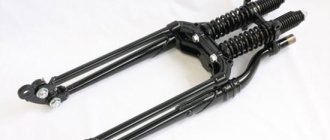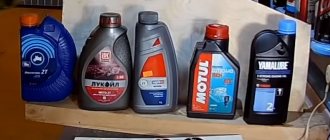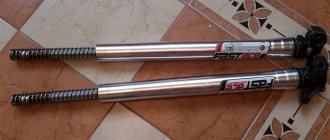Four-stroke scooter engines are subject to increased loads during operation in urban conditions. To prevent premature wear of metal surfaces, it is necessary to use lubricants. One such product is Motul SCOOTER EXPERT 4T oil. Thanks to this product, fuel consumption is significantly reduced. Reduces wear and provides consistent corrosion protection.
Product Description
The oil is made from synthetic-based materials with the addition of a complex of high-quality additives (Technosynthese technology). The lubricating fluid ensures stable operation of the clutch in an oil bath. The product has stable properties that are maintained during sudden temperature changes, as well as overheating in city driving conditions. It has a low level of volatility, which reduces the cost of constantly replenishing the oil level in the engine. Thanks to additives, it prevents the appearance of dirt and carbon deposits on internal surfaces.
The line includes two types of oil: Motul SCOOTER EXPERT 4T 10W40 MA and Motul SCOOTER EXPERT 4T 10W40 MB. Both products are semi-synthetic, but are superior in quality to many synthetic oils from other brands.
Suitable for mixing with mineral and synthetic oils, no negative reactions have been observed.
What kind of oil to put in a motorcycle
The choice depends primarily on the type of motorcycle.
- Equipment with two-stroke engines requires diluting the fuel with oil. It is poured into the tank in the required proportion or dosed using a special system. The clutch and gearbox mechanisms are located in a closed housing and are lubricated separately.
- It's more difficult with four-stroke motorcycles. Gearbox lubrication is always necessary; the clutch can be dry or wet. In the first case, only the cylinder-piston group and gearbox are lubricated.
With a wet clutch, its mechanism is in an oil bath; the piston group and gearbox parts are also lubricated.
The oil in four-stroke motorcycles is located in the crankcase, from where it is supplied to components that require lubrication. Oil containers can be shared or separate: each unit has its own.
We recommend reading: What kind of oil to fill in the engine of a Ural motorcycle
Is it possible to add car oil?
Oils intended only for motorcycles do not contain some anti-friction additives. The manufacturer does this deliberately to prevent slipping of the wet clutch. Therefore, automobile oil is often superior in lubricating properties to motorcycle oil. The piston and gearbox will not suffer from it, and it will not get any worse.
It's all about the clutch. If it is in an oil bath, slipping is possible with automotive lubricant.
If the vehicle has a dry clutch, it does not matter what kind of oil to use. Automotive lubricant can be used in 2-stroke motorcycles for the CPG, gearbox, provided that it does not get on the clutch.
Owners of four-stroke vehicles should take into account that the load on a motorcycle engine is higher than on a car engine. Therefore, replacing motorcycle oil with low-viscosity machine oil will lead to premature engine wear.
If you change, then only for high-quality products, and not on the principle of “what is cheaper.”
Material on the topic: Review of motor oils. Video
Best motorcycle oil
Large companies involved in motorcycle equipment recommend their own brand for lubrication. Most manufacturers are limited to requirements regarding lubricant parameters without specifying the brand. Motorcyclists should follow recommendations regarding oil characteristics.
This may be of interest: SAE 30 for 4-stroke air-cooled engines
The most complete and convenient classification is SAE, which takes into account viscosity-temperature properties.
For four-stroke engines, the main thing is viscosity.
- It is recommended to use all-season SAE 10W40 in Japanese equipment. It is also suitable for the Chinese Racer motorcycle. Versatility is not a good quality. In winter, this oil thickens greatly, and in the heat it becomes more liquid. It is better to use it in warm weather.
- For fans of speed and driving in cool weather, SAE 5W30 synthetic is recommended. It has low viscosity, does not get cold in the cold, and engine power does not drop. These advantages have a negative side: when developing high speeds, the engine squeezes out the lubricant. The protective layer disappears, metal parts wear out faster.
- In an effort to increase engine life, many choose SAE 10W50. This is a highly viscous oil, with which scuffing or other irreversible defects are practically excluded. But it is only suitable in summer; when the temperature drops slightly, it can be difficult to start the motorcycle.
- If it is above +28°C outside, the best oil is SAE 15W60. The engine with it in such heat loses only 0.5% of power.
According to European standards, class A oils are suitable for motorcycles. At the same time, for new equipment, A1 and A2 are used, and A3 is poured into old equipment. Marked B and C are suitable for diesel engines.
You can hear from sellers that there is no classification of oils for 2-stroke engines. This is not true; according to the European standard, there are the following types of lubricants:
- TA – with engine volume up to 50 cm³;
- TV – for engines 100-300 cm³;
- Vehicle – for engines 300 cm³ and more.
According to the Japanese classification, the division of lubricants is as follows:
- FA – highly accelerated engines;
- FB – city motorcycles;
- FC – mopeds.
For domestic engines, which are produced using outdated technologies, oil is chosen especially carefully. Two-stroke units were designed for M8 lubricant. The best reviews from motorcyclists are about the Russian oil MGD-14M. Based on the results of operating the equipment, it is clear that certain parameters are superior to foreign analogues.
Imported oil in domestic four-stroke engines foams, as a result, pressure drops, which leads to breakdown. It is better to use Russian M8V1, which is highly resistant to scuffing and wear.
This is recommended to be poured into the popular Ural bike. If this lubricant is not available, use any mineral or semi-synthetic one. M10G2K has average results.
Specifications
Motul SCOOTER EXPERT 4T 10W-40 MA
| Parameter | Test method | Value/Units |
| Viscosity grade | SAE J 300 | 10W-40 |
| Density at 20°C (68°F): | ASTM D1298 | 0.874 g/cm3 |
| Viscosity at 40°C (104°F): | ASTM D445 | 95.4 mm²/s |
| Viscosity at 100°C(212°F): | ASTM D445 | 14.9 mm²/s |
| Viscosity index: | ASTM D2270 | 164 |
| Pour point: | ASTM D97 | -33°C / -27°F |
| Flash point: | ASTM D92 | 228°C / 442°F |
| Base number | ASTM D2896 | 7.9 mg KOH/g |
Motul SCOOTER EXPERT 4T 10W-40 MB
| Parameter | Test method | Value/Units |
| Viscosity grade | SAE J 300 | 10W-40 |
| Density at 20°C (68°F): | ASTM D1298 | 0.864 g/cm3 |
| Viscosity at 40°C (104°F): | ASTM D445 | 102.1 mm²/s |
| Viscosity at 100°C(212°F): | ASTM D445 | 14.6 mm²/s |
| Viscosity index: | ASTM D2270 | 150 |
| Pour point: | ASTM D97 | -35°C / -31°F |
| Flash point: | ASTM D92 | 232°C / 449.6°F |
| Base number | ASTM D2896 | 7.1 mg KOH/g |
Common Myths
Even among experienced motorcyclists, there are ridiculous stories about motor oils for motorcycles. Let's dispel some of them.
- When the motorcycle accelerates, the oil in the engine accumulates on the rear wall and does not work as it should, so you need to fill it with a thicker one. The author of this gem, apparently, has little idea what happens in the engine when it reaches at least 5 thousand rpm. The counterweights of the crankshaft and gearbox gears scatter oil with such intensity, and such a violent blizzard of oil is created inside the engine that pressing the lubricant against the rear wall of the crankcase is out of the question.
- If you filled in the wrong oil, scrap the engine and look for a new one. It is very unlikely that using the wrong motorcycle oil, even over a period of time, will destroy the engine. Will cause some damage - yes. Rather, the engine can be killed by systematically raising the speed to the cutoff, its overheating, untimely maintenance, as well as counterfeit oil with catastrophically low properties. Of course, if you go so far as to pour two-stroke oil into a 4-stroke engine, expect bad news. But if instead of 10W40 you filled in a good motorcycle analogue with a viscosity of 5W30, nothing critical will happen.
- The four-stroke, four-cylinder internal combustion engine is the same as in a car, and you can safely pour oil into the car. This is wrong. There is a difference, and it is fundamental. The design of the gearbox and clutch on a motorcycle is very different from a car. Therefore, it is impossible to systematically use standard automotive lubricants for motorcycles.
Advantages and disadvantages
The main advantages include:
- the product forms a stable protective film on metal surfaces;
- has enhanced cleaning and dispersing properties, which prevents the formation of dirt and deposits on internal surfaces;
- at maximum loads, premature wear is prevented;
- provides stable protection against corrosion and rusting;
- does not undergo oxidation, foam does not form as a result of the ingress of water vapor;
- thanks to the use of oil, fuel consumption is reduced;
- ensures stable starting at low temperatures, and also prevents overheating during city driving.
There were no consumer deficiencies noted.
Scooter with four stroke engine
For scooters with a regular gearbox, 4t oil is suitable, but if your scooter has a CVT gearbox, then you need gear oil. In the case of a 4t scooter, the choice of oil comes down to the same principle as for a 2t. That is, it all depends on the riding style, the technical condition of the moped and also its age. If we talk about four-stroke mopeds, then it is recommended to fill them with 10w-40 oil. In principle, a moped can run on regular car oil, but use such oil at your own peril and risk. The oil must protect all rubbing parts well, and there are a large number of them in the engine. And the scooter clutch especially needs high-quality oil, since it literally floats in oil.
If we are talking about what kind of oil to pour into cubic capacity motorcycles, then two-stroke synthetic is better. This way the cylinder-piston group will remain clean and well preserved. This oil is the most resistant to various temperatures. Also, synthetic scooter oil produces less soot, which settles in the muffler and clogs it.
Why change the oil
I met a person who did not change the oil for 3 seasons. His ATV was being repaired and there was little left of the oil, everything was covered in soot. And the engine was working in this one, it’s good that it was still working at all. But it significantly reduced its service life, and the repairs cost a pretty penny.
As mentioned, a good synthetic oil prevents the formation of carbon deposits and is resistant to temperatures. Carbon deposits interfere with engine operation and reduce its service life, complicate the life of compression rings and cause overheating. And given that the amount of carbon deposits is constantly increasing, plus constant overheating, repairs will not take long. And expensive motorcycles require expensive repairs. Therefore, it is not recommended to skimp on oil.
And what will happen if you don’t change the oil, you will find out from the video:
How much oil to put in a scooter
Each scooter needs a different amount of oil. But using the golden rule this can be easily understood. After all the oil has been drained from the crankcase, you need to measure how much of it came out and then fill in the same amount plus 3-5 percent. If the scooter is new, then you don’t have to add 3-5%, and fill in as much as you drain.
Source
Type of engines
As you know, scooters can be divided into two categories: those with a two-stroke engine and those with a four-stroke engine. Both categories have both pros and cons. We won’t delve into the operating principle of each of them, but let’s talk about oil - a mandatory element for the normal operation of any scooter.
In two-stroke engines, oil burns in the fuel chamber along with oxygen and gasoline, so this oil has completely different requirements during operation. It is radically different from the four-stroke. It is important to remember that two-stroke and four-stroke oil are not interchangeable and should only be used on the corresponding engines.
Lubricants for scooter powertrain
Scooter engines, which originally had only a two-stroke design, in modern cars have invariant operating principles. Mobile urban transport is increasingly equipped with four-stroke engines, especially for vehicles manufactured in China.
The principle of lubrication of the bearing supports of the crankshaft and the cylinder-piston group, as is known, is fundamentally different in engines with two and four strokes. Accordingly, there are significant differences in the oils that should be used.
A closed system for lubrication of the rubbing elements of a four-stroke engine involves the use of lubricants whose physical and technical properties ensure a long service life without loss of their basic properties. In scooters with two-stroke engines, on the contrary, good performance results are provided by oils that can burn in the combustion chamber of the internal combustion engine without the formation of excess amounts of soot components. The combustion of oil, among other things, should not be accompanied by excessive smoke.
Lubrication of four-stroke engines
The first and most important caveat regarding lubrication for four-stroke engines may sound trivial: motor oil for a scooter should be used that is recommended by the engine manufacturer. There is one important nuance in this truism: very common Chinese-made cars are equipped with engines whose manufacturers are located far beyond the borders of the Middle Kingdom.
There are motors that were discontinued in Japan or the USA 10–15 years ago, Korean-made power plants, and others. It seems difficult to find exotic products from ten years ago in the constantly updated range of lubricants. The question naturally arises - what kind of oil to pour into a scooter whose engine is recommended to have a lubricant that no longer exists.
In such cases, a simple rule of thumb follows. The oil must ensure the creation of a reliable separating film under the conditions that accompany the operation of the power plant. Conditions include:
Scooters are used mainly in the warm season. Accordingly, the viscosity that the lubricant being poured must have must ensure that its properties are maintained exclusively at positive or slightly negative outside temperatures. According to the SAE classification, these classes include oils of the 5W30, 10W40 and 10W50 classes. These are the lubricants that are recommended for use in four-stroke scooter engines by major manufacturers and experienced users.










